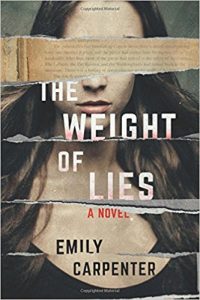Women’s Fiction With A Side Of Horror
 When my youngest son was five, he loved the History Channel show MonsterQuest. I let him watch it without supervision, assuming it had to be fairly tame. He didn’t seem to be scared by it exactly, just a little…obsessed. At some point, he became aware that there were DVDs of all the episodes, and he asked if we could order them. “Sure,” I said.
When my youngest son was five, he loved the History Channel show MonsterQuest. I let him watch it without supervision, assuming it had to be fairly tame. He didn’t seem to be scared by it exactly, just a little…obsessed. At some point, he became aware that there were DVDs of all the episodes, and he asked if we could order them. “Sure,” I said.
When they arrived, he hustled down the hall to snuggle in Mom’s bed and watch monsters. Later, over dinner, he announced to the family that he wanted to tell us about one of his favorites, the one know as…
…The Boneless Whore.
My husband, two older sons, and I froze.
“WHAT did you say?” I squeaked as my husband fixed me with an accusing glare: What have you done to our child? What have you allowed his young mind to be polluted with?
“The Boneless Whore,” my darling, innocent child repeated matter-of-factly.
“Please. Tell us all about her,” said my other son.
I’m assuming he did tell us – not that we heard a word he said, as we had all begun to choke back tears of hysterical laughter. Like, the kind of laughter where you cannot catch your breath, no matter how hard you try. He looked at us all like we were crazy, and repeated the name, for good measure, at least a half a dozen more times. Which just spun the paroxysm of giggles into stratospheric levels.
Long story short, the monster in question turned out to be, not an unfortunate scarlet woman sans a skeleton, but a gargantuan octopus that enjoyed attacking and sinking ships. “The Boneless Horror.” For me, the takeaway from the whole ordeal was an understanding of how my son dealt with the things that frightened him. Watching a show about monsters was a little trick he played on himself. If he watched the big terrifying thing –and survived – he was that much stronger and a little less scared the next time. A fear inoculation. Smart kid.
Experts believe there are several reasons why people like to read scary stories (or watch them). Some thrill-seekers simply crave the dopamine high of the fight-or-flight response. Others like to win over fear, itself – you know, that one thing we’ve been told we truly have to fear. As long as we, the readers, know we’re truly safe, we can allow ourselves to vicarious experience all sorts of horrific situations in the pages of a book, ultimately triumphing over them. And actually look at it as an entertaining, satisfying experience.
Lisa Cron, in her book Wired for Story says, “We think in story. It’s hardwired in our brain. It’s how we make strategic sense of the otherwise overwhelming world around us.” Our brains learn from scary stories – they take in information and make plans for future contingencies. We prepare ourselves for the worst, perhaps so it’ll never happen, the same way my son did with his monster DVDs.
Like my son, when I was a young girl, I was obsessed over scary stories.
My mother dutifully steered me to the classics, then the not-so-classics – the Nancy Drews, Hardy Boys, and Bobbsey Twins – those happy, wholesome purveyors of small-town justice. But somewhere along my sunny path of gentle reads, I stumbled across a few macabre volumes I could never forget:
*That YA book about the boarding school where the faculty summons up the spirits of dead artists to possess the students so they can create more classic works of art.
*The short story about the boy who collects moths, until one moth gets its horrifying revenge.
*The book about the girl who lives in a strangely shaped house and discovers the previous occupant was a witch.
*The novella about the two kids in the English countryside who either pretend to communicate with ghosts or really do and drive their governess mad with fear.
I could never forget the gut-twisting, hair-raising feeling those tales gave me. They made me feel lots of ways that Bert, Nan, Flossie and Freddie weren’t able to make me feel:
Electrified. Alive. Questioning the reality of the sleepy suburbia in which I lived.
If “Horror” as a genre brings to your mind monsters, ghosts, and grisly murder, I wouldn’t be surprised, but I prefer to think of the word in terms of emotion. Merriam-Webster defines horror as “a painful and intense fear, dread, or dismay” and, by that definition, all sorts of literature is shot through with elements of horror.
My latest book, for instance, goes for these emotions in a pretty straightforward way. It’s the story of a woman who must step out from the long shadow her famous mother, a bestselling horror novelist who wrote an iconic novel forty years ago, casts. On one level, it’s about finding success and independence apart from the people – maybe even über-successful people – who shaped us. On another level, it’s a modern take on the old-school horror genre.
I had so much fun writing it, and, who knows, maybe my brain benefited from me writing about running through shadowy hallways and tangling with snakes on an isolated island off the coast of Georgia. I hope that the quirky mashup that’s resulted – women’s fiction with a side of horror – electrifies readers. And that, together, protagonist and reader can navigate a few dark, frightening places and get to the other side.
—
EMILY CARPENTER, a former actor, producer, screenwriter, and behind-the-scenes soap opera assistant, was born and raised in Alabama. After graduating from Auburn University, she moved to New York City and now lives in Georgia with her family. She is the author of Amazon bestselling BURYING THE HONEYSUCKLE GIRLS and THE WEIGHT OF LIES. Visit Emily at emilycarpenterauthor.com and on Facebook and Twitter
About The Weight Of Lies
 In this gripping, atmospheric family drama, a young woman investigates the forty-year-old murder that inspired her mother’s bestselling novel, and uncovers devastating truths—and dangerous lies.
In this gripping, atmospheric family drama, a young woman investigates the forty-year-old murder that inspired her mother’s bestselling novel, and uncovers devastating truths—and dangerous lies.
Reformed party girl Meg Ashley leads a life of privilege, thanks to a bestselling horror novel her mother wrote decades ago. But Meg knows that the glow of their very public life hides a darker reality of lies, manipulation, and the heartbreak of her own solitary childhood. Desperate to break free of her mother, Meg accepts a proposal to write a scandalous, tell-all memoir.
Digging into the past—and her mother’s cult classic—draws Meg to Bonny Island, Georgia, and an unusual woman said to be the inspiration for the book. At first island life seems idyllic, but as Meg starts to ask tough questions, disturbing revelations come to light…including some about her mother.
Soon Meg’s search leads her to question the facts of a decades-old murder. She’s warned to leave it alone, but as the lies pile up, Meg knows she’s getting close to finding a murderer. When her own life is threatened, Meg realizes the darkness found in her mother’s book is nothing compared to the chilling truth that lurks off the page.
Category: On Writing






























